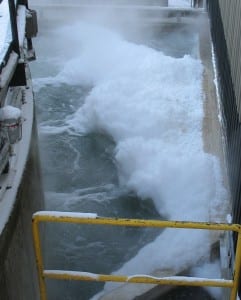The Situation:

Original Poor Mixing Pattern
An industrial plant was using a combination of boiler stack gas and expensive carbon dioxide (CO2) to lower the pH of its recycled water, which needed to be neutral prior to use.
The company was adding stack gas at several points in the treatment train using simple coarse bubble diffusers in a clarifier center well and a subsequent pH adjustment tank.
Because the stack gas was unable to achieve the neutral pH in the last reaction tank, the company was also purchasing and injecting CO2 into the clear well near the water supply pumps that fed the manufacturing process.
At times, the purchased CO2 was foaming downstream as the pumps sucked in the CO2 gas and pumped out a supersaturated gas/water mixture. The foaming water interfered with the production process and caused operation curtailments.
Though the client was ultimately creating the neutral water they needed, they knew there had to be a better, more cost-effective way to accomplish the task.
The Solution:
Mr. McKinnon observed that the individual stack gas diffusers were ineffective in mixing the gas throughout the water column in the reaction tank. As a result, much of the stack gas escaped undissolved, losing the pH adjustment potential. In addition, most of the water was never exposed to the stack gas as it passed through the uneven gas distribution in the tank.

New Spiral Roll Mixing Pattern
Mr. McKinnon proposed that the plant staff build an alternative stack gas diffuser array using commonly available pipes and existing stack gas connection points. He instructed the staff to arrange the diffusers to create a spiral roll mixing pattern to trap the gas bubbles in the turbulent flow path and mix them through the entire water column.
The Result:
Following a successful test run of the trial array, the team installed a permanent pipe diffuser. The permanent array proved to be so successful that the client has not purchased CO2 since its installation – saving the company at least $13,000 annually by neutralizing water pH without reliance on expensive CO2.
In addition, the improved mixing of the stack gas has allowed mill operators to throttle the gas flow, producing the desired pH at lower gas flows. This has produced the added benefit of better pH control with reduced pH variability, improving overall water quality for the facility.
See the spiral roll mixing pattern in the videos below:
Leave a Reply